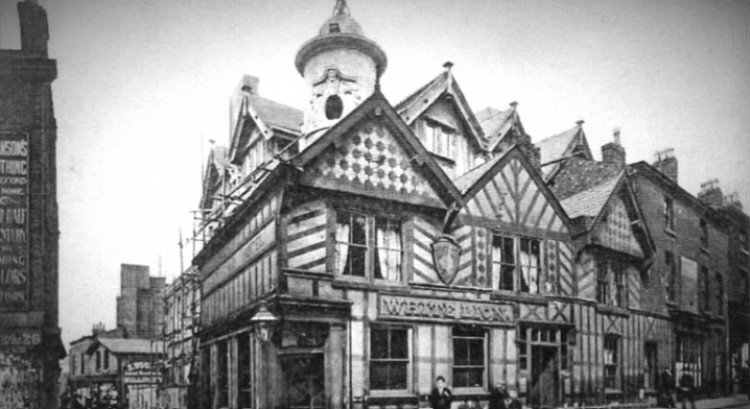Local history feature - the history of The White Lion
By Nub News guest writer 1st Oct 2023
By Nub News guest writer 1st Oct 2023

The Stockport Heritage Trust have very kindly produced this local history feature for readers. Stay tuned for more!
By Jill Trumble
The White Lion has its origins in the mists of time. It was a half -timbered house dating back to the 14th century that may have been established to accommodate visitors to the local gentry, the Ardernes and Leghs, and others whose townhouses were nearby.
The White Lion had rights of turbary, that is the freedom to cut peat for fuel, and for fishing in the River Mersey. It also had at least one dedicated pew in St. Mary's parish church where guests could worship. The inn was situated on open land with gardens stretching back to the river and a fashionable bowling green was added in the sixteenth century.
The heyday of the White Lion was in the mid-eighteenth century. It became the principal inn and posting house in the town, where civil functions and mayors' banquets were held. There were daily coaches to Manchester, Liverpool, Buxton and towns southward to London. It held a good reputation.
The local Justices also met at the White Lion and, in 1757, when they were trying to recruit men to serve in the militia, a riot broke out. Three hundred armed men stormed the building, attacked the landlord, William Ellison, and burst into the magistrates' room, demanding the lists of the townships from them.
A further demand for money from the constables for the mob to drink to the king's health was also made. Their grievance was about pay. Sixpence a day was the rate offered, a third of the old amount. They stated that they would 'as long as life should last serve for the old price of eighteen pence a day' and marched off proclaiming "We are for no sixpence a day militia".
During the Peninsular Wars of 1807-1814, a signal cannon outside the White Lion was fired when the London mail coach arrived and any news of the conflict was read out publicly by the town crier, to the interested crowds that had gathered.
The inn was up for sale in 1822. The original building was re-fronted about 1832 and two years later there was a change of use when the banqueting hall became a public singing room. In 1823, a wooden bridge was built over the Mersey next to the inn by the Stockport Philanthropic Society for easier access to Heaton Lane. Taking its name from the society's watch word of 'union', the original structure was rebuilt in 1858 and replaced by a metal one in 1870 and was re-named Vernon Bridge.
An unusual event took place on March 25th 1831 when Willliam Clayton brought his wife to the inn for sale. She was paraded around the yard of the premises with a halter round her neck, then sold for 5/- (25 pence) to a man named J. Booth.

The industrial revolution saw the end of the pleasure grounds when the land was taken up for the erection of an iron foundry.
In 1882, the White lion boasted five sitting rooms, a commodious travellers' room, tap room, nine bedrooms, three servants' chambers, an excellent kitchen and brewhouse, offices and stabling for 24 horses.
Demolition started in 1902 on the old building and the new one opened in 1904. It was built behind the façade of the old one. It was considerably larger with twenty bedrooms and bathrooms, games rooms and a coffee room and was to become a first class modern hotel.
The new inn was set back from the road and built in the English Renaissance style, remaining in use as a public house with function rooms until renovation in the 1980s, when the staircase was removed and function rooms went into disuse.
The White Lion, the original of which was almost certainly the oldest hostelry in the town, closed for business in the 21st century. It has been extensively renovated and converted into apartments, with an intention that the ground floor will be used as a bar/restaurant.
~
Those interested in learning more about Stockport's heritage can visit the heritage centre Tuesday 11am – 2pm and Saturday 10.30 – 2pm. The centre is situated inside St. Mary's Parish Church, Market Place, on the left hand side past the cafe.
The heritage trust also opens the former courthouse and dungeon to the public on the second Saturday of every month, from 10.30am until 3.30pm, or when the last visitor leaves.
The trust's website can be found HERE
~
Free from clickbait, pop-up ads and unwanted surveys, Stockport Nub News is a quality online newspaper for our town.
To get our top stories in your inbox each week, subscribe to our free weekly newsletter HERE.
Please consider following Stockport Nub News on Facebook or Twitter
CHECK OUT OUR Jobs Section HERE!
stockport vacancies updated hourly!
Click here to see more: stockport jobs
Share:























